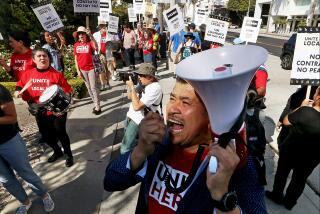Income disparity is wide in L.A.
- Share via
Los Angeles has one of the highest levels of income inequality in the nation, but that’s due in part to a relatively strong local economy that’s stoking the fortunes of higher-income people, according to a new study.
Of the 50 largest U.S. cities, L.A. has the ninth-highest level of income disparity, according to the analysis by the Brookings Institution, a Washington think tank. The top three are Atlanta, San Francisco and Miami.
Inequality has become a flash point nationwide as the wealth of top earners surges while the middle and lower classes grapple with stubborn income stagnation. Politicians have clashed loudly on what’s driving the dichotomy.
The study found, however, that rising inequality may simply be an unavoidable byproduct of robust local economies that plump the incomes of coveted workers.
Fast-growing industries with highly paid employees -- such as technology, finance and entertainment -- tend to cluster in large metropolitan areas, said Alan Berube, a Brookings researcher who specializes in inequality. And the ongoing gentrification of many cities, such as in downtown L.A., is drawing wealthier people.
At the same time, big cities also draw large numbers of low-income people seeking lower-skilled jobs.
The study analyzed inequality in the 50 largest U.S. cities in 2012. It compared the earnings of a family exactly at the top 5% -- that is, at the 95th percentile of all U.S. households -- to one at the 20th percentile.
The average annual income of a top 5% family was 10.8 times higher than a bottom 20% household. For the country as a whole, the ratio was 9.1 to 1.
“It’s not necessarily a bad thing that big cities are home to more rich and poor than the rest of the country,” Berube said. “The question is how do cities and leaders navigate that but keep their cities diverse and able to provide opportunities for upward mobility.”
In L.A., a top 5% household made an average $218,000. That was 12.3 times higher than a 20% household.
The study analyzed only the city of L.A. It did not include nearby areas with well-heeled residents, such as Beverly Hills or Santa Monica.
The inequality debate intensified after President Obama in December called it “the defining challenge of our time.”
Critics worry that income imbalances weaken cities by hiving off rich from poor. Among other things, that can push out younger residents, lead to pockets of entrenched poverty and undermine school quality.
Even some extremely wealthy Americans acknowledge the threat of rising inequality.
“It’s a genuine problem,” Stephen Schwarzman, the chief executive of private-equity giant Blackstone Group, said in an interview with The Times on Thursday. “It’s been growing for over 30 years. It’s not recent. It’s something that has to be addressed.”
San Francisco illustrates the dynamic of a vibrant economy exacerbating the gap between rich and poor.
The tech boom has dramatically pushed up the earnings of those at the top.
The average $353,000 income for a top 5% household towered over that of every other city. Its inequality ratio was 16.6 to 1.
In Atlanta, a top 5% family took in $280,000, compared with less than $15,000 for a bottom 20% family.
Inequality tends to be lower in cities with less robust economies, where there is less of a gap between the highest and lowest paid, according to Brookings.
Altogether, 18 cities in the Brookings study suffered a statistically significant rise in inequality from 2007 to 2012. But that was due more to the bottom dropping out for low-income people in the last recession.
“Most were not places where the rich made astronomical gains, but where low-income households suffered most from the recession and weak recovery,” the study said. “Many are Southern and Western cities -- including Sacramento, Charlotte [N.C.], Tucson, Fresno, and Albuquerque -- where house-price collapses reduced work opportunities for poor households.”
--
More to Read
Inside the business of entertainment
The Wide Shot brings you news, analysis and insights on everything from streaming wars to production — and what it all means for the future.
You may occasionally receive promotional content from the Los Angeles Times.










